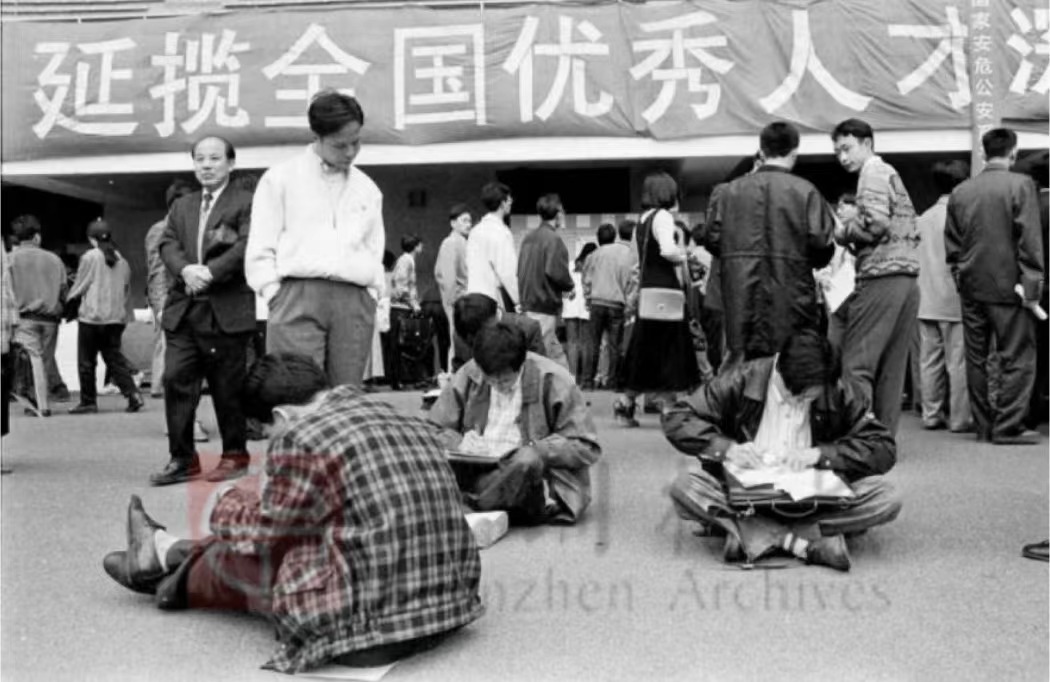
在网络和智能手机高度发达的今天,求职者们足不出户就可以投递简历,获取信息。而在上世纪80年代,人们都要走出家门,实地找工作。乘着改革开放的春风,深圳率先建设人才大市场,为求职者提供了巨大便利,也为全国人才市场的形成和发展起到了示范作用。
Thanks to the Internet and the development of smart phones, job hunting has become more convenient as people no longer have to leave home to apply for a job. But things were much different in the 1980s. To help people in their job seeking process, Shenzhen took the lead in China to set up a talent market, where job seekers and employers could go through procedures from interviews and tests to offer confirmations.
深圳人才大市场的建立经历了从酝酿到成熟的过程。1984年,深圳市人才服务公司成立,为深圳市人事局下属单位,主要负责处理求职者信件、接待求职者和推荐岗位,1991年更名为深圳市人才服务中心,主要开展人才培训、流动人员管理以及为外商投资企业、外商驻深代表机构服务等方面的工作。同年10月,全国第一个常设型人才市场“深圳市人才智力市场”(深圳人才大市场前身)在华强南路2号正式筹建,标志着我市人事制度改革和人才交流工作迈出了崭新的一步。后因社会需求迅速增长,1993年,深圳市人才智力市场搬迁至华强北。
In 1984, the Shenzhen Talent Service Company was set up to process job seekers’ letters, receive job seekers when they visited and recommend jobs to them. In 1991, it was renamed Shenzhen Talent Service Center to reflect the addition of more services for jobs seekers, including training programs and the management of people without a Shenzhen hukou, as well as services for foreign-invested enterprises and branches of foreign enterprises. In October 1991, the Shenzhen Talent Intelligence Market, the first permanent talent market in China, which was later developed into the Shenzhen Talent Market, was set up at 2 Huaqiang Road South, and in 1993, it was moved to Huaqiangbei.
1996年6月,为进一步满足人才需求,新的深圳人才大市场在罗湖区宝安北路动工,仅建设一百天时间即竣工。深圳人才大市场为供需双方提供了包括交流、计划、调配、考试、录用等在内的全方位“一条龙”服务,并制订了管理规定和操作程序,使整个市场的运作逐步规范化和制度化。资料显示,1998年,进场求职人数达1474759人次,20432家单位提供岗位达166577个。
In June 1996, construction on the new building for the Shenzhen Talent Market started and was completed after 100 days. A series of services, including interviews, job planning, job reallocation, testing and offer confirmation, were provided at the market. Regulations and work procedures were also formulated to standardize the running of the market. In 1998, the talent market received more than 1.4 million visits from job seekers, and more than 20,000 employers that provided 166,577 jobs through the market.

深圳人才招聘会上延揽全国优秀人才的大型横幅(图片由罗湖区档案馆提供)
A large banner saying “recruit talents from all over the country” at a job fair in Shenzhen. (Courtesy of the Luohu Archives)
1998年4月16日,为更好地服务社会经济建设,深圳市人才服务中心与深圳市人才大市场合并组建为“深圳市人才交流服务中心”,为深圳市人事局下属事业单位,主要提供人才交流中介、人事代理、人才测评服务,行使管理人才市场行业等职能。
On April 16, 1998, the Shenzhen Talent Service Center and Shenzhen Talent Market were merged into a new organization named Shenzhen Talent Exchange and Service Center.
尽管深圳人才大市场已渐渐退出了人们的视野,但它汇聚了四面八方的求职者,为无数“伯乐”提供了“千里马”,成为了改革开放初期内地人闯深圳的“第一站”。
Although the Shenzhen Talent Market is no longer a center for job seekers, it served as the first stop for many people who came to work in Shenzhen from across China in the 1980s, connecting them to numerous employers.
今日互动:生活在深圳的您,是否曾听说过“二线关”这个词呢?关于“二线关”,您有着哪些与它相关的记忆或故事?欢迎留言分享,小i将在留言中抽取三位幸运儿送出小礼物。敬请关注下期故事《特区管理线的建设》。
Today's topic: Have you ever heard of the control line of the Shenzhen Special Economic Zone? What memories or stories do you have about it to share? Feel free to leave your comments and three lucky people who share their stories will receive gifts. The answer will be revealed in the next story: “Construction of the Shenzhen Special Economic Zone control line.” Please stay tuned.

来源:深圳市档案馆、i深圳
Source: Shenzhen Archives, iShenzhen
编译:深圳政府在线、Shenzhen Daily、GDToday
Transedited by: Shenzhen Government Online, Shenzhen Daily, GDToday